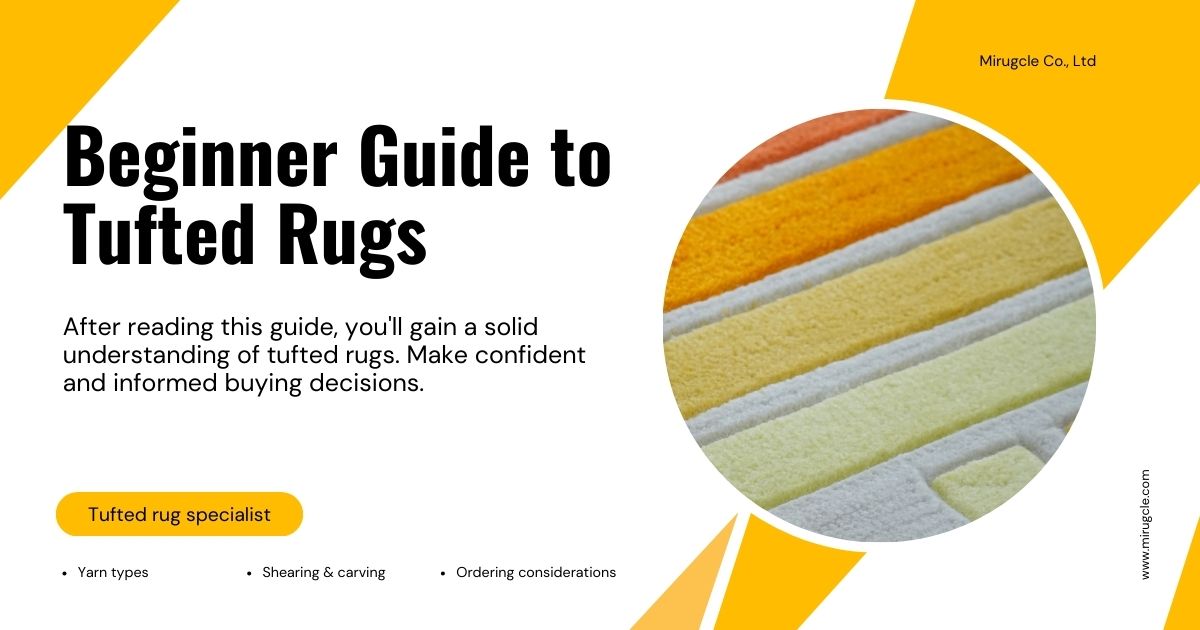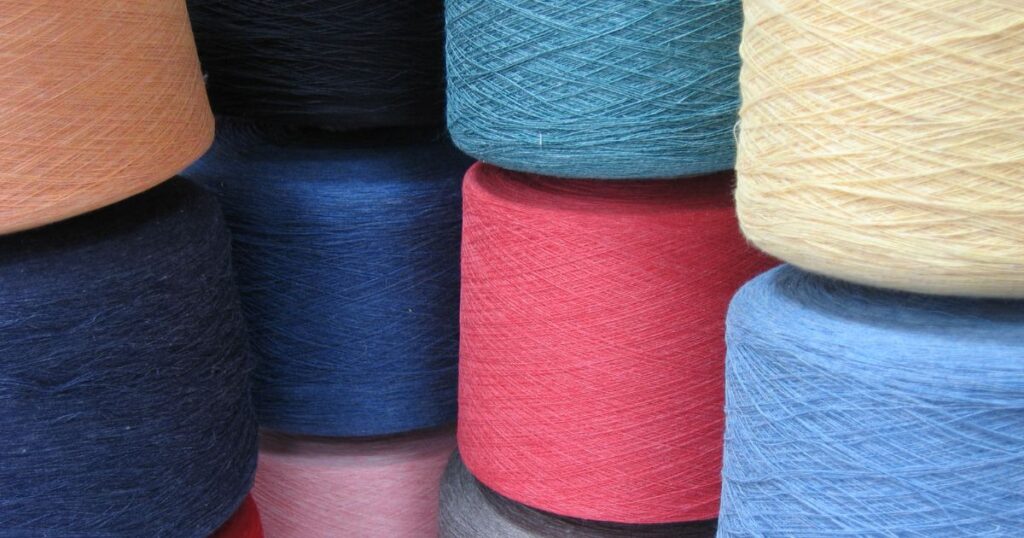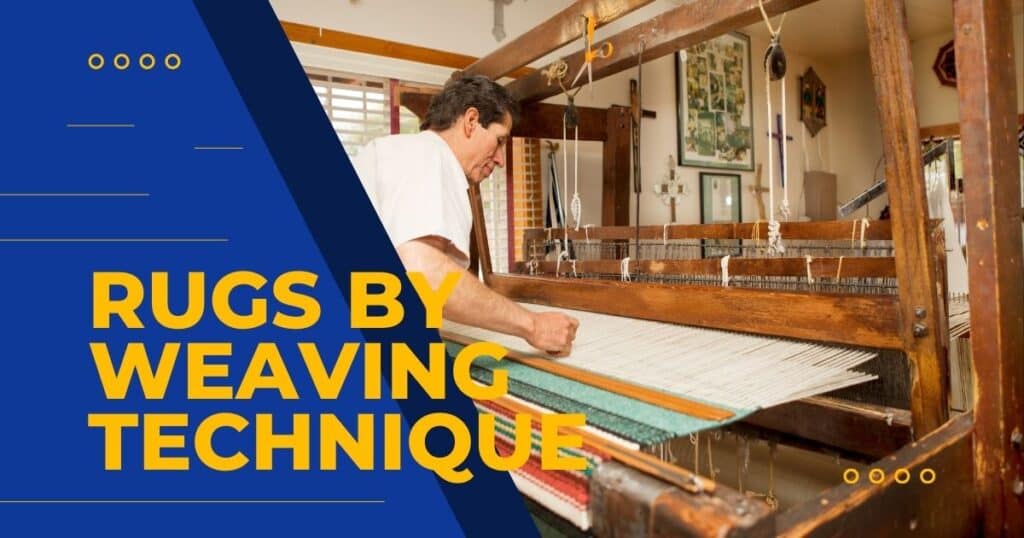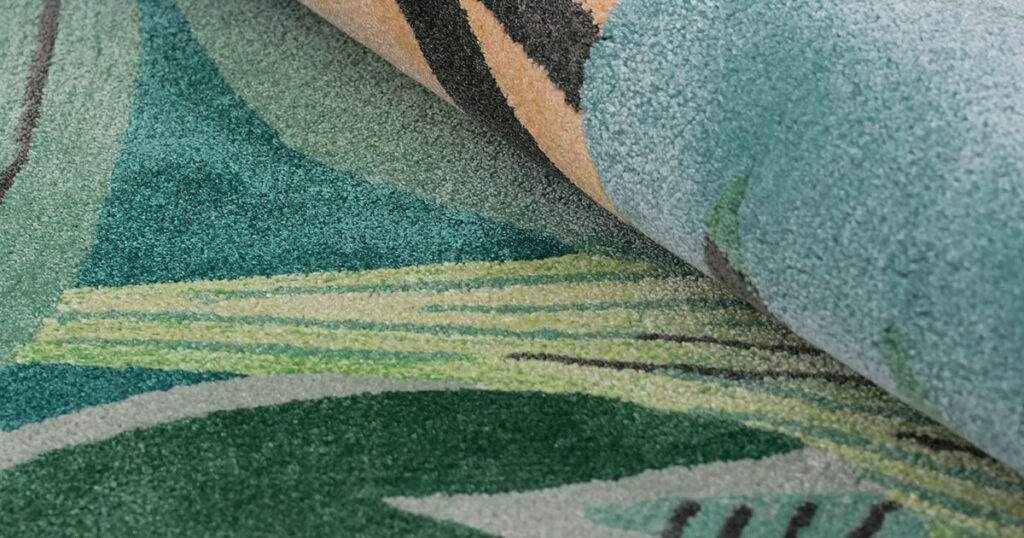If you’re exploring tufted rugs for your commercial spaces, you’ve made a smart choice to investigate this popular option.
This guide provides all the essential information you need at your initial research stage.
What Are Tufted Rugs?
Tufted rugs are constructed by punching yarn through a backing fabric rather than weaving or knotting each strand. In the creation process, yarn is threaded through a base cloth (often cotton or polyester canvas) using a tufting tool or gun. As the yarn is pushed through, it forms loops on the front side of the rug.
These loops can be left uncut to produce a textured “loop pile,” or they can be cut to create the soft, fuzzy surface known as “cut pile”.
After tufting the entire design, the loops are secured in place on the back of the rug with an adhesive (commonly latex or another rug glue).
A secondary backing material (like cotton canvas or mesh fabric) is usually applied over the glue to give the rug stability and a finished look.
This method skips the time-consuming knotting process of traditional hand-knotted rugs by using glue to hold the fibers, which is why tufted rugs can be made much faster.
Hand-Tufted vs. Machine-Tufted
In hand-tufting, a skilled artisan uses a handheld tufting gun to manually punch yarn into the design on the fabric frame. The artisan follows a stenciled pattern on the cloth, filling in the design with colored yarns. This process is relatively quick — an entire rug can sometimes be completed in a day or two, depending on its size and complexity. Hand-tufting allows for a lot of artistic control: the tufter can change yarn colors, adjust pile height, and even carve details after tufting.
In machine-tufting, the principle is the same (loops of yarn are inserted into a backing), but it’s done on an industrial scale. A mechanized tufting machine with hundreds of needles inserts yarn in rows across a broad backing fabric. The machine controls the pattern (often guided by a computer for complex designs) and can rapidly produce carpet or rugs. After machine tufting, glue and backing are applied similarly. Machine-tufted rugs are essentially mass-produced tufted rugs, often made from synthetic yarns for efficiency.
Essential, manual tufting and machine tufting are the same production technique.
The critical part – tufting gun is the same.
Below is the components of our tufting machines that actually do the jobs.
Despite differences in how they’re made, all tufted rugs share key construction features: loops of yarn held in a backing cloth and secured by adhesive. From the front, a tufted rug presents a continuous field of yarn pile (loop or cut). If you flip it over, you will usually not see individual knots or a woven structure. Instead, you’ll see a fabric backing covering the entire back (often a canvas material) that’s been glued on. This backing hides the tufting ends and glue and gives the rug a neat finish.
Key Differences
Understanding these differences will help you make the right choice for your commercial needs:
Craftsmanship & Design
Hand-tufted rugs are made by artisans guiding a tufting gun by hand. This means each rug, even if based on a template, has a bit of human touch. Hand-tufting is relatively less labor-intensive than knotting, which frees artisans to experiment with different materials and very intricate or curvy patterns. It’s possible to achieve elaborate, flowing designs (like floral motifs or modern abstract art) because the tufter isn’t restricted by a grid of knots.
Machine-tufted rugs are made on automated machines, which results in perfectly uniform tufts and very consistent patterns. While they can also execute many designs (especially with computerized control), machine-tufted rugs often stick to common patterns and may have less of the “handmade character.”
Materials
Hand-tufted rugs often use natural fibers, especially wool, for the face yarn. Wool is a popular choice because it’s durable and has a high-quality look and feel. However, because hand-tufting is quicker and cheaper than knotting, makers might also use other fibers (like silk accents, cotton, or viscose) or blends.
Machine-tufted rugs most commonly use synthetic yarns such as polypropylene, polyester, or nylon. These fibers are chosen for their low cost and ability to be produced in bulk. You will occasionally find machine-tufted rugs in wool or cotton, but it’s less common and usually in higher-end machine rugs.
Durability
Because of the differences in materials and construction oversight, hand-tufted rugs tend to be mid-range in durability. A well-made hand-tufted wool rug can easily last several years (often 5-10 years or more with proper care).
In fact, if maintained carefully, some can last up to a decade or two before significant wear.
Machine-tufted rugs, especially those made with cheaper synthetics and made in high volume, usually have a shorter expected lifespan — sometimes only a few years in a busy household before they start to flatten or the fibers/adhesive break down.
The key difference is often quality control and materials: hand-tufted rugs, coming from a tradition of rug-making, might use better wool and adhesives, whereas discount machine-tufted rugs aim for low cost which can mean lower quality components.
Cost
Hand-tufted rugs occupy a mid-range price point in the rug world. They are much more affordable than hand-knotted rugs (which can take months to weave), but they usually cost more than the most mass-produced machine-made rugs. Prices for hand-tufted rugs range widely based on size, fiber, and brand — you might find small wool hand-tufted accent rugs for under $100, while a large, high-quality hand-tufted rug could be a few thousand dollars.
Machine-tufted rugs (especially synthetic ones) are often the most budget-friendly option. These can range from very cheap (tens of dollars for a small rug) up to a moderate price for large or branded pieces, but generally they’re less expensive than comparable hand-tufted.
Advantages for Commercial Spaces
Affordable Craftsmanship
Tufted rugs provide the look of a handmade rug without the extreme price tag. Because the tufting process is faster and less labor-intensive than tying thousands of knots, these rugs are generally much cheaper than hand-knotted rugs.
You can get a large, beautiful wool rug at a fraction of the cost of a knotted one.
- For example, you can order a customized tufted rug large enough to cover the front floor of a commercial movie theater.

This makes them ideal for buyers who want style on a budget. Tufted rugs are popular in home decor shows and stores specifically because they are efficient and cost-effective to produce compared to hand-knotted rugs.
Faster Turnaround & Custom Designs
If you want a custom rug with specific colors or a unique pattern, tufting is one of the quickest ways to get it made. A hand-knotted custom rug might take months or even a year; a hand-tufted custom rug can often be completed in weeks. Manufacturers highlight that tufted rugs offer quicker production without much quality compromise compared to other handmade options.
This speed also means tufted rugs are more responsive to trends — you can find fashion-forward designs and seasonal colors that might not be feasible in slower rug-making methods.
Endless Design Possibilities
Tufting allows for a high degree of design flexibility. Since the yarn is punched into a fabric, the tufter (human or machine) can follow virtually any pattern drawn on the cloth. Curvy lines, complex floral motifs, bold modern geometric shapes — all are achievable. Unlike weaving, tufting isn’t limited by a grid of warp threads, so even very intricate or curvilinear patterns come out nicely.
This is great for custom orders: you can have your own artwork or a specific motif translated into a tufted rug. Different pile heights can also be combined (for example, loops and cut pile in the same rug) to create texture and depth in the design, something that can be harder to do in other rug types.
Below is a simple custom tufted rug with only black and white strips.
Below is a small section – approximately 50 x 50 cm – of a beautifully tufted custom rug.
Such irregular custom details may not be possible with other rug weaving techniques.
Thick and Plush Feel
Tufted rugs, especially hand-tufted ones, often have a thick, cushy pile that feels soft underfoot. The process easily produces a high pile height if desired, and multiple strands of yarn can be tufted closely for density. Many tufted rugs are quite substantial — if you pinch a hand-tufted rug, it might feel thick and resist compression.
This plushness can add a lot of comfort and warmth to a room, making tufted rugs popular for bedrooms and living areas where you might sit or play on the rug.
Attractive Look
From the front, a well-made tufted rug can be indistinguishable from more expensive types. Hand-tufted rugs in particular can mimic the look of hand-knotted rugs’ patterns quite well.
They often use high-quality wool that takes dye beautifully, resulting in rich colors. Many tufted rugs feature on-trend designs and can easily become a focal point in your decor. They also typically come without the slight irregularities that hand-knotted rugs might have, so the pattern will be clean and the lines crisp.
Disadvantages to Consider
Limited Durability
The Achilles’ heel of tufted rugs is their lifespan. Because the fibers are glued into place rather than knotted, tufted rugs are generally less durable than hand-knotted or woven rugs. They tend to last only as long as the adhesive backing holds up.
Over time (especially under heavy foot traffic), the glue can degrade or loosen, causing tufts to pop out or the rug to start shedding excessively. A well-made tufted rug might give you many years of service, but don’t expect it to become a family heirloom.
As one rug expert bluntly puts it: “Tufted rugs are not durable. They last only as long as the adhesive glue holding them together.”
Shedding of Fibers
It’s quite common for new tufted rugs (especially wool ones) to shed loose fibers for a while. When the rug is made, some fibers aren’t fully secured or are excess from cutting, so you’ll notice fluff coming off initially.
Wool hand-tufted rugs often shed in the beginning and require frequent vacuuming at first. This usually tapers off after a few months of regular vacuuming.
However, continuous heavy shedding can be a sign of a lower-quality tufted rug (perhaps using shorter staple fibers or poor glue).
Adhesive
When new, some tufted rugs emit a chemical or rubbery odor. High-quality manufacturers usually use better latex that doesn’t smell, but cheaper tufted rugs (particularly some imported ones) have been known to have a strong latex odor that smells like rubber or even like slightly “sour” or mildewed socks. This happens if inferior latex was used or if it had begun to spoil before application.
That smell is very hard to get rid of (since it’s the rug’s backing itself); it can off-gas in your room and bother sensitive noses.
Over time, latex adhesive can break down. Old tufted rugs sometimes show a crusty, powdery substance coming out from the back — that’s the latex dry-rotting and crumbling. When the glue breaks down, the rug will start to fall apart (tufts loosening and shedding).
Cleaning Limitations
Tufted rugs can be tricky to clean thoroughly. Surface cleaning with a vacuum is fine, but if you have a serious spill or pet accident, you cannot easily wash a tufted rug without risking damage. Why? Because water or cleaners soaking into the backing can soften or break down the glue.
Professional rug cleaners often have trouble with tufted rugs: if you submerge a tufted rug in a cleaning bath (a common method for deep cleaning wool rugs), the backing can deteriorate or release nasty smells. Also, any liquid that penetrates through the tufted face is likely to get trapped in the latex and between the backing layers — it’s hard to rinse out, meaning stains and odors can linger.
Common Rug Yarns
The material choice significantly impacts performance, appearance, and price. Here’s what commercial buyers should know.
Wool
Wool is by far the most popular premium material for tufted rugs. It’s used in most higher-quality hand-tufted rugs. Wool is durable and resilient — it can handle foot traffic and spring back from compression, so wool rugs keep their look for a long time. It’s naturally dirt-resistant to a degree (wool fibers have lanolin which repels dust) and even somewhat flame-resistant (wool doesn’t ignite easily, a safety plus).
Wool also feels warm and cozy, and it’s a renewable natural fiber. Good wool (like New Zealand wool) takes dye beautifully for rich colors.
Downsides include higher cost than synthetics, potential wool allergies, and initial shedding.
Best for: Executive offices, hotel lobbies, upscale lobbies, and anywhere you want a long-lasting rug with a high-quality feel.
Nylon
Nylon is one of the strongest, most durable synthetic fibers for rugs. It has excellent resilience, meaning it can spring back after being compressed by footsteps or furniture. Nylon is often treated to be stain-resistant (e.g., treatments like Scotchgard can make it repel spills).
It’s also resistant to mold and mildew, and it doesn’t mind a humid environment. Cleaning nylon rugs is usually easy — many stains can be cleaned with water and mild detergent without damage.
The feel of nylon is not as luxurious as wool but offers excellent durability.
Best for: High-traffic areas where you need durability — e.g., hallways or conference rooms that will see a lot of action.
Polyester
Polyester can be made to feel very plush — some shaggy tufted rugs use polyester to get a super-soft, silky touch. It’s generally resistant to fading, so colors stay bright. Polyester is also relatively inexpensive, and it’s hydrophobic (meaning it doesn’t absorb water easily), so spills might blot up before sinking in.
Polyester tends to crush under weight and doesn’t have the spring of wool or nylon, so it might look flattened in high-traffic zones.
Best for: Low to medium traffic areas where you want a soft feel and shiny look, such as waiting rooms or lounge areas.
Polypropylene (Olefin)
Polypropylene is cheap and widely available. It’s highly stain-resistant to most substances (except oil-based stains) and it doesn’t absorb moisture, so it’s often used in indoor-outdoor rugs. It’s also lightweight. As a fiber, it’s solution-dyed (color is added during fiber production), so the color is part of the fiber and resists fading and bleach.
Polypropylene is the least resilient fiber — it crushes easily and can even flatten permanently under furniture. It has a lower melting point, so heat can damage it. In tufted rugs, polypropylene is mostly seen in cheaper machine-tufted ones (like basic area rugs from big-box stores).
Best for: Budget rugs and places where you might replace the rug in a couple of years.
Where Tufted Rugs Work Best
Executive Offices & Meeting Rooms
A tufted rug can make an office feel more inviting. It will absorb sound (good for conference calls) and give a professional yet comfortable vibe. If you have rolling office chairs, note that rolling on a thick rug is tough, so either get a lower pile or use a chair mat on top of part of it.
Hotel Rooms & Hospitality Areas
Tufted rugs are used in commercial settings like hotels (think of those huge lobby rugs with the hotel logo or ballroom rugs with intricate patterns). They choose tufted because of the ability to do large-scale patterns and logos and the faster production.
Moderate Traffic Common Areas
Ideal placements are moderate-traffic, comfort-oriented spaces. Avoid the soaking wet or ultra-heavy traffic scenarios if you want them to last.
Areas to Avoid
Because the fibers are glued into place rather than knotted, tufted rugs are generally less durable than hand-knotted or woven rugs. This makes them less ideal for main entrances, high-traffic corridors, or areas prone to spills and heavy cleaning.
How to Evaluate Quality
Fiber Quality and Content
Check what the yarn is made of. 100% New Zealand wool or high-grade wool generally indicates a quality rug. Wool should feel soft but also a bit springy and sturdy. If the rug is wool but feels very scratchy or sheds excessively just from running your hand over it, it might be lower-grade wool or blended with cheaper fibers.
Density of Tufts
How closely packed are the yarn tufts? A denser tufted rug means more yarn was used per area, which generally correlates to better quality (and durability) because there’s less empty space and the yarn will stay upright better. You can test density by pressing your fingers on the rug — do you easily feel the base cloth, or is it well covered with yarn? If you can easily part the pile and see the backing or large gaps, that rug is on the thinner, sparser side.
Backing Material
Flip the rug (or corner) and look at the backing. Quality hand-tufted rugs usually have a sturdy cotton canvas backing cloth that’s neatly adhered. The backing might be a single piece of fabric with possibly tape binding at the edges.
If you see a plastic mesh or a very thin papery fabric as backing, that might be a lower-end construction. Also, see if the backing is well attached — are there areas where it’s loose or coming unglued?
Adhesive Quality
If possible, ask the seller or manufacturer about the adhesive used. Higher quality tufted rugs use better latex or synthetic rubber that stays flexible a long time.
Cheap ones might use a low-quality latex with fillers (sand or ash fillers are sometimes used) that break down sooner.
If you can fold the rug a bit, a good adhesive shouldn’t crack or make a crackling sound. A really bad sign is if you rub the back and get powder or crumbs coming off — that means the glue is already breaking (common in older or very cheap tufted rugs).
Essential Maintenance
Regular, Gentle Vacuuming
Vacuum your tufted rug regularly to remove dust and dirt from the fibers. Grit can act like sandpaper on the yarn, wearing it out faster, so keeping the rug clean is key to durability. However, be gentle: use a vacuum without a harsh beater bar, or use the suction-only setting or an upholstery attachment.
Use a Quality Rug Pad
A rug pad underneath is strongly recommended. Pads do a few things: they keep the rug from slipping (important for safety and to prevent tugging the rug which can loosen tufts), they add cushioning (reducing the impact of footsteps on the rug and floor), and they help with air circulation when vacuuming.
Prompt Spill Response
If you spill something on a tufted rug, time is of the essence. Blot (don’t rub) the spill with a clean, absorbent cloth or paper towel. Try to soak up as much liquid as possible before it seeps down. Avoid using excessive water or cleaner, because you don’t want to saturate the backing. For most spills, a small amount of mild detergent or rug cleaner on a cloth can be used to gently dab the area, then blot with water to rinse, then blot dry.
Professional Cleaning
Every couple of years, it’s good to have a rug professionally cleaned to remove deep dirt. But make sure the cleaner is experienced with tufted rugs.
Do not allow them to submerge-wash it unless they know what they’re doing, as that could ruin the backing. Many professional rug cleaners will do a low-moisture cleaning or surface shampoo for tufted rugs, or use controlled extraction.
Final Thoughts
Tufted rugs offer an excellent balance of aesthetics, comfort, and cost for commercial spaces. While they won’t last as long as hand-knotted rugs, they provide significant value through:
- Design flexibility for branding and aesthetic purposes
- Cost-effectiveness for spaces that undergo periodic refreshes
- Comfort and acoustic benefits that improve user experience
- Relatively quick custom ordering for specific needs
When selecting tufted rugs for your commercial spaces, focus on quality materials (particularly wool for higher-end spaces), appropriate placement based on traffic patterns, and implementing proper maintenance protocols to maximize your investment.
By understanding these fundamentals, you’ll be well-equipped to make informed decisions about incorporating tufted rugs into your commercial environments.
















